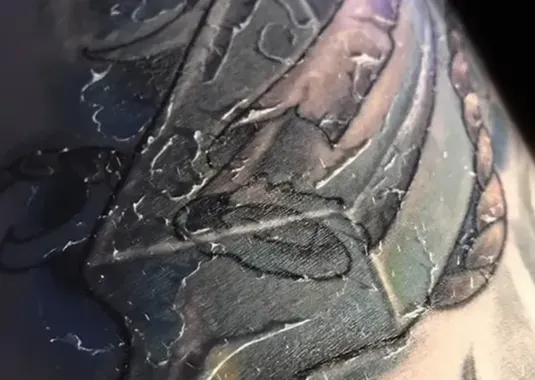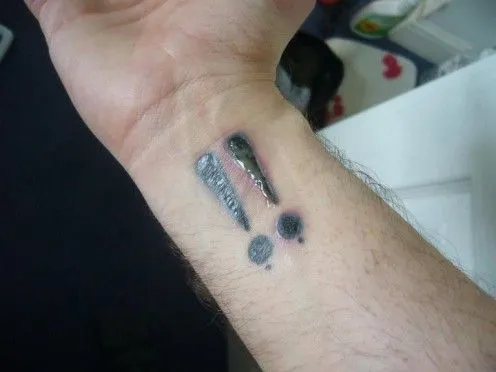
The day you get your tattoo is the day it will look its most vibrant, crisp, and brilliant—even more than expected—at least until it is fully healed. Within the first few days of receiving your new ink, your new tattoo may begin to look dry and dull and start to peel. You may start to wonder if it is normal for a tattoo to peel and how it will look “on the other side.”
Fortunately, it is completely normal for a new tattoo to scab over and peel. It’s part of the natural healing process as a tattoo is a type of a wound, and your body sloughssluffs away the old dry skin cells to make way for new cells.
That said, if you find your new tattoo peeling excessively, it could be a sign of something that’s not quite right. For example, heavy peeling may be a sign of acute inflammation or even an infection.
When is a peeling tattoo completely normal versus a sign of an issue?
Quick Recap: Tattoo Healing
Sitting through the tattoo process is only the beginning. Because it’s a fresh wound, —though intentionally inflicted—the skin starts the healing process. This process can take several weeks or months, depending on you, the condition of your skin, how well you follow the aftercare instructions, the type and location of the design, how you eat and drink (staying hydrated and eating healing foods is good for the skin), and the skill of your tattoo artist.
Tattoos are created by penetrating needles into the upper and middle layers of skin (i.e., the epidermis and dermis). As the skin heals, part of the process includes exfoliation, or the dead skin cells sloughingsluffing off to make way for new skin cells.
Just like any open wound, the skin is vulnerable during the healing process, which is why tattoo aftercare is such an important step for the next few weeks. This aftercare will also help you closely observe how well your tattoo is healing, so you can take any issues or questions you have to your tattoo artist or healthcare professional.
When Does a Tattoo Start Peeling?
You will likely notice your tattoo starts to peel within the first week, after the initial tattoo bandages are removed. You may also notice scabs that naturally slough sluff off in the second week. The skin, as well, will look duller due to the dead, dry skin over the tattoo.
Fortunately, this is only temporary. Over the next couple of weeks, your new tattoo will begin to look vibrant again as the skin naturally heals.
Don’t, however, try to rush the process by scrubbing away the skin. Because the skin is still healing, it’s vulnerable, and excessively washing it or scrubbing it can only damage the tattoo, so the skin never heals as well as it could.
As the tattoo heals, you’ll also likely find the skin looks pink or red under and around the tattoo. It will likely also look slightly raised due to the inflammation. This is normal—as long as the swelling doesn’t extend well beyond the tattoo. Fresh tattoos also itch as the skin peels. However, it’s also important to avoid scratching or rubbing the tattoo, which can damage the skin and distort the tattoo. A little dab of healing tattoo balm or lotion may help ease the itch and promote recovery. Avoid the use of petroleum-based creams (e.g., Vaseline), which may cause the tattoo ink to fade.
Remember to also follow the tattoo aftercare instructions from your tattoo artist and for your particular tattoo bandage. Use this guidance to remove the bandage as instructed. And then keep the tattoo cleancleaned by gently washing it with fragrance-free, skin-sensitive, antibacterial soap and clean water two to three times per day. Use a lotion, balm, or cream designed for a new tattoo as instructed. And then avoid wearing tight clothing or allowing anything to rub on the healing skin. It’s also important to avoid exposing the newly tattooed skin to UV light from the sun or tanning beds to help prevent fading.
How Do You Know If the Tattoo Isn’t Healing Well?
It’s also possible to have an infected, peeling tattoo that isn’t normal. If you have the following symptoms, it’s time to reach out to a healthcare provider:

- Red, swollen rashes can indicate your skin isn’t accepting the ink, and you may even be having an allergic reaction. If you already have a skin condition like eczema, rosacea, or psoriasis, a new tattoo can also cause a flare-up.
- Excessive swelling combined with heat, redness, and peeling could also indicate an allergic reaction, a flare-up of an existing skin condition, or an infection.
- Intense itching: while itching is common with a healing tattoo, if the itch is excessive and doesn’t lessen when you use a small amount of balm, it could also indicate infection or an allergic reaction.
- Discharge or fluids beyond the first couple of days. When you first get a tattoo, it’s normal for the tattoo to ooze plasma, ink, and even blood. However, if that lasts more than a couple of days, it could indicate an inflection is taking hold. Please see a healthcare provider immediately, especially if the discharge comes with a fever and chills.
What If Your Tattoo Doesn’t Peel?
Lucky! All people have different ways of healing. You may not peel until later (if you develop scabs) or even at all. There’s no need to encourage the skin to peel (such as by exfoliating), which can damage the skin and tattoo. You just heal a little differently.
To continue to encourage the tattoo to heal, remember to avoid:
- Soaps, ointments, or other products that contain a fragrance
- Picking or scratching any peeling or itchy skin
- Using an antibacterial ointment like Neosporin
- Swimming, using a hot tub, getting in a sauna, or taking a bath (you can, however, shower—just avoid running the hot water directly on the new tattoo as much as possible)
- Exposing the tattoo to direct sunlight or UV from tanning beds
- Using sunblock over a tattoo before it has a chance to fully healed
- Wearing tight clothing or clothing that rubs against the tattoo.
Tattoo Peeling Takeaway
It’s totally normal for a tattoo to start to peel within the first week of receiving your new ink. Your tattoo may continue to slough sluff off skin for up to four weeks. Fortunately, after a couple of weeks, the skin will heal and stop peeling. If the tattoo still peels, reach out to a dermatologist (a doctor who specializes in skin) for advice.
